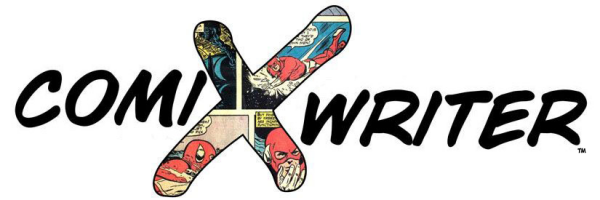_________
By Matt O’Keefe
There is only one right way to properly script a movie. If you don’t follow the established template, your script won’t be taken seriously. It needs to have the correct font, margins, line breaks, etc.to be accepted by studios or writing workshops. Comic scripts, on the other hand, have no such limitations. As shown on the Comic Book Script Archive, writers script their comics in a number of different styles. Below are five ways authors can tell their stories.
Word Processor — Established Template

While there is no universally recognized format for scripting comics, there are certain existing templates endorsed by industry professionals. Former Marvel editor Andy Schmidt and Book Club Manager Paul Allor created a comic script template for Schmidt’s Comics Experience online courses. Click here to download a copy.
This is a good choice for writers looking for something that is, above all else, reliable. It’s unlikely an editor would be displeased by a format supported by someone as respected as Schmidt. His Comics Experience template is strongly suited for someone who isn’t looking to reinvent the wheel.
Word Processor — Custom Format

Most comic book writers like to add some of their own flair when formatting their scripts. Fred Van Lente shares his personal scripting style here. Thanks to Jim Zub for referencing it in one of his invaluable tutorials.
Sometimes a pre-established template, no matter how thorough and well thought out, won’t offer a way for a writer to incorporate a new or uncommon technique in his or her script. The most obvious solution is to customize your scripting style so that it can do what you need it to do.
Screenwriting Software

Marvel heavyweight Brian Michael Bendis, among other writers, uses screenwriting software to script his comics. The biggest benefit, as Bendis says in his Tumblr post, is that it encourages you to keep writing. The software auto-formats as you write and remembers character names and settings.
The downside is that neither Hollywood standard Final Draft nor other screenwriting options have a well-regarded comic scripting format, so you have to essentially design your own template. In this author’s opinion, there are ways to script a comic that are equally effective without the extra hassle.
Scrivener

Scrivener has always flown under the radar, but it’s one of the most versatile writing programs out there. For writers in any medium, the software is a valuable tool because of its adaptability and export options. More to the point, Scrivener has a great comic script template designed by Antony Johnston. The author of Umbral, Wasteland, and Umbral explains the benefits and potential of Scrivener better than I could ever hope to.
NOTE: Robert Marland recently developed a downloadable template inspired by Van Lente’s scripting style that auto-formats and is usable in Microsoft Word. You can view and download it here. It looks great, but is fairly new so it hasn’t yet been incorporated into established software like Johnston’s has. At least not yet.
ComiXwriter

ComiXwriter launched a Kickstarter campaign in June of 2013 to fund development costs for what it calls “the first software solely dedicated to writing scripts for comic books and graphic novels.” It promises to include features such as the ability to make notations on the page and automated pages, panel numbers, spacing, etc. that allow you focus on story, not format.
Two aspects promised in the fundraiser separate ComixWriter from a program like Scrivener. One is its collaborating function, which offers easy side-by-side viewing of the script and the artwork. The other is the inclusion of several already-installed comic-scripting templates, as opposed to just one. If it delivers what the Kickstarter promised, it could be the most intuitive and effective way to script comics. I interviewed one of its creators, Glenn Farrington, to learn more. Look for that discussion soon.





Speaking as someone who uses FinalDraft — yeah, you basically need to customize your own template. But once you do, man, it’s a dream to use.
So I’d say it’s worth doing the upfront work to create the template, because after you’ve done that, it’s buttah.
kdb
Kurt: Maybe I should give Final Draft another look. I like Scrivener both because it has a pre-programmed template and it can include cover notes, solicits, summaries, etc. all in one document.
-Matt
You forgot about Celtx (www.celtx.com). It comes with a comic book script template too.
What I want is a two-paged format. One page is the script, the second page is the notebook where I can link reference photos, URLs, panel layouts for artists. Items would link to specific pages and panels, automatically reformatting as I type and edit.
I just wish more writers/editors/publishers who have decided to jump into the “comic biz” even considered that there may be relatively standard formats for writing comics in. I do a lot of freelance lettering and some of the scripts I’ve seen have been formatted in ways beyond frustration. I even had a project once where the comic was adapted from a prose story, so for the lettering, what did they send me? The prose story. Yep, where the artist took that story and broke it down into panels, etc., they expected me to just know what times a character said what in the story would go into what panel and where, what words to bold or italicize, or what sound effect to use when the text reads “a gun shot rang out!” What is that, is that “bang”? “Pow”? “Kablam”?
The problem with scripting comics is that all our standard formats are based on something else, theater, film, whatever. This method, based on Alison Bechdel’s innovation, is awkward to learn, but once you do, it’s the most versatile and native-to-comics method I’ve ever used. And I’ve used a bunch.
Check it out–worth trying.
http://jessicaabel.com/2013/02/11/visual-scripting-using-indesign-to-write-comics/
I have a copy of Dillinger movie script by John Milius: He didn’t follow modern formatting standards + it’s all past-tense / :)
I’ve written ‘standard scripts’ for submission editors and have sold them–but after the sale, I discovered that in small-press GloBL comics, every artist has her own way of drawing ‘from script’. Some like the ‘prose paragraph with dialog’ style, some want dialog with layout thumbs, while others want the strict western style that’s considered ‘DC or Marvel style’.
I don’t submit to the big guns, mainly because I like the idea of pairing with an artists first and then tailoring my story to a script that she can follow. The ultimate goal is to produce something you’re both happy with as creators–and I think it’s a team effort (at least it is in small-press comics).
Dark Horse has their format here:
http://www.darkhorse.com/Company/Submissions#writers
No surprises there.
Mr. Busiek’s format (especially the notation on how to depict lettering) from Astro City 1/2 is very good.
Jon: I didn’t include Celtx because while the format looks pretty good while scripting, when it’s exported it turns into a wildly different format. At least it did when I last used it.
-Matt
This is just what I needed!
Comments are closed.